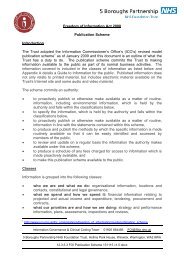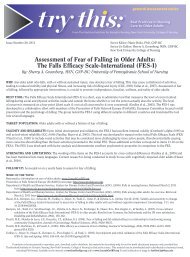5 Boroughs Partnership NHS Foundation Trust Annual ... - Monitor
5 Boroughs Partnership NHS Foundation Trust Annual ... - Monitor
5 Boroughs Partnership NHS Foundation Trust Annual ... - Monitor
Create successful ePaper yourself
Turn your PDF publications into a flip-book with our unique Google optimized e-Paper software.
Notes to the Accounts - 1. Accounting Policies (Continued)<br />
The effective interest rate is the rate that discounts exactly estimated<br />
future cash receipts through the expected life of the financial asset or,<br />
when appropriate, a shorter period to the net carrying amount of the<br />
financial asset.<br />
Interest on loans and receivables is calculated using the effective interest<br />
method and credited to the Statement of Comprehensive Income.<br />
Other financial liabilities<br />
All other financial liabilities are recognised initially at fair value, net of<br />
transaction costs incurred, and are measured subsequently at amortised<br />
cost using the effective interest method. The effective interest rate is the<br />
rate that discounts exactly estimated future cash payments through the<br />
expected life of the financial liability or, when appropriate, a shorter period<br />
to the net carrying amount of the financial liability.<br />
They are included in current liabilities except for amounts payable more<br />
than 12 months after the Statement of Financial Position date, which are<br />
classified as long-term liabilities.<br />
Interest on financial liabilities carried at amortised cost is calculated using<br />
the effective interest method and charged to Finance Costs. Interest on<br />
financial liabilities taken out to finance property, plant and equipment or<br />
intangible asets is not capitalised as part of the cost of those assets.<br />
Impairment of financial assets<br />
At the Statement of Financial Position date, the <strong>Trust</strong> assesses whether<br />
any financial assets - other than those held at 'fair value through income<br />
and expenditure' - are impaired. Financial assets are impaired and<br />
impairment losses are recognised if, and only if, there is objective<br />
evidence of impairment as a result of one or more events which occurred<br />
after the initial recognition of the asset and which has an impact on the<br />
estimated future cash flows of the asset.<br />
1.13 Public Dividend Capital<br />
Public Dividend Capital (PDC) is a type of public sector equity finance<br />
based on the excess of assets over liabilities at the time of establishment<br />
of the predecessor <strong>NHS</strong> <strong>Trust</strong>. HM Treasury has determined that PDC is<br />
not a financial instrument within the meaning of IAS 32.<br />
A charge, reflecting the cost of capital utilised by the <strong>Trust</strong>, is payable as<br />
Public Dividend Capital dividend. The charge is calculated at the rate set<br />
by HM Treasury (currently 3.5 per cent) on the average relevant net assets<br />
of the <strong>Trust</strong> during the financial year.<br />
<strong>Annual</strong> Report and <strong>Annual</strong> Accounts 2011-12 193








